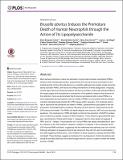| dc.contributor.author | Guzman-Verri, Caterina | |
| dc.contributor.author | BARQUERO-CALVO, ELIAS | |
| dc.contributor.author | Mora-Cartín, Ricardo | |
| dc.contributor.author | Arce-Gorvel, Vilma | |
| dc.contributor.author | de Diego, Juana L. | |
| dc.contributor.author | Chacón-Díaz, Carlos | |
| dc.contributor.author | Chaves-Olarte, Esteban | |
| dc.contributor.author | Buret, Andre | |
| dc.contributor.author | Gorvel, Jean-Pierre | |
| dc.contributor.author | Moreno, Edgardo | |
| dc.date.accessioned | 2020-06-19T22:50:26Z | |
| dc.date.available | 2020-06-19T22:50:26Z | |
| dc.date.issued | 2015-05-06 | |
| dc.identifier.uri | http://hdl.handle.net/11056/17601 | |
| dc.description.abstract | Most bacterial infections induce the activation of polymorphonuclear neutrophils (PMNs), enhance their microbicidal function, and promote the survival of these leukocytes for protracted periods of time. Brucella abortus is a stealthy pathogen that evades innate immunity, barely activates PMNs, and resists the killing mechanisms of these phagocytes. Intriguing clinical signs observed during brucellosis are the low numbers of Brucella infected PMNs in the target organs and neutropenia in a proportion of the patients; features that deserve further attention. Here we demonstrate that B. abortus prematurely kills human PMNs in a dose-dependent and cell-specific manner. Death of PMNs is concomitant with the intracellular Brucella lipopolysaccharide (Br-LPS) release within vacuoles. This molecule and its lipid A reproduce the premature cell death of PMNs, a phenomenon associated to the low production of proinflammatory cytokines. Blocking of CD14 but not TLR4 prevents the Br-LPS-induced cell death. The PMNs cell death departs from necrosis, NETosis and classical apoptosis. The mechanism of PMN cell death is linked to the activation of NADPH-oxidase and a modest but steadily increase of ROS mediators. These effectors generate DNA damage, recruitments of check point kinase 1, caspases 5 and to minor extent of caspase 4, RIP1 and Ca++ release. The production of IL-1β by PMNs was barely stimulated by B. abortus infection or Br-LPS treatment. Likewise, inhibition of caspase 1 did not hamper the Br-LPS induced PMN cell death, suggesting that the inflammasome pathway was not involved. Although activation of caspases 8 and 9 was observed, they did not seem to participate in the initial triggering mechanisms, since inhibition of these caspases scarcely blocked PMN cell death. These findings suggest a mechanism for neutropenia in chronic brucellosis and reveal a novel Brucella-host cross-talk through which B. abortus is able to hinder the innate function of PMN. | es_ES |
| dc.description.abstract | La mayoría de las infecciones bacterianas inducen la activación de los neutrófilos polimorfonucleares (PMN), mejoran su función microbicida y promueven la supervivencia de estos leucocitos durante períodos prolongados. Brucella abortus es un patógeno sigiloso que evade la inmunidad innata, apenas activa los PMN y resiste los mecanismos de destrucción de estos fagocitos. Los intrigantes signos clínicos que se observan durante la brucelosis son el bajo número de PMN infectados por Brucella en los órganos diana y la neutropenia en una proporción de los pacientes; características que merecen una mayor atención. Aquí demostramos que B.abortus mata prematuramente a los PMN humanos de forma dosis dependiente y específica de la célula. La muerte de los PMNs es concomitante con la liberación de lipopolisacáridos intracelulares de Brucella (Br-LPS) en vacuolas. Esta molécula y su lípido A reproducen la muerte celular prematura de los PMN, un fenómeno asociado a la baja producción de citoquinas proinflamatorias. El bloqueo de CD14 pero no de TLR4 previene la muerte celular inducida por Br-LPS.La muerte celular de las PMNs se produce por necrosis, NETosis y apoptosis clásica. El mecanismo de la muerte celular de las PMN está vinculado a la activación de la NADPH-oxidasa y a un modesto pero constante aumento de los mediadores ROS.Estos efectores generan daños en el ADN, reclutamiento de la quinasa 1 de punto de control, caspasas 5 y, en menor medida, de la caspasa 4, RIP1 y Ca++liberación. La producción de IL-1β por los PMNs fue apenas estimulada por la infección de B.abortus o el tratamiento de Br-LPS. Asimismo, la inhibición de la caspasa 1 no obstaculizó la muerte celular de PMN inducida por Br-LPS, lo que sugiere que la vía del inflamosoma no estuvo implicada. Aunque se observó la activación de las caspasas 8 y 9, no parecían participar en los mecanismos de activación iniciales, ya que la inhibición de esas caspasas apenas bloqueaba la muerte de las células PMN. Estos hallazgos sugieren un mecanismo para la neutropenia en la brucelosis crónica y revelan un nuevo cruce entre el huésped de Brucella y B.abortus, que puede obstaculizar la función innata de la PMN. | es_ES |
| dc.description.sponsorship | Universidad Nacional, Costa Rica | es_ES |
| dc.language.iso | eng | es_ES |
| dc.publisher | PLoS Pathogens | es_ES |
| dc.rights | Acceso abierto | es_ES |
| dc.source | PLOS Pathogens May 6, 2015 | es_ES |
| dc.subject | BRUCELLA ABORTUS | es_ES |
| dc.subject | BRUCELOSIS | es_ES |
| dc.subject | BACTERIAS | es_ES |
| dc.subject | HUMAN | es_ES |
| dc.title | Brucella abortus induces the premature death of human neutrophils through the action of Its lipopolysaccharide | es_ES |
| dc.type | http://purl.org/coar/resource_type/c_6501 | es_ES |
| dc.description.procedence | Escuela de Medicina Veterinaria | es_ES |
| dc.identifier.doi | 10.1371/journal.ppat.1004853.g010 | |

